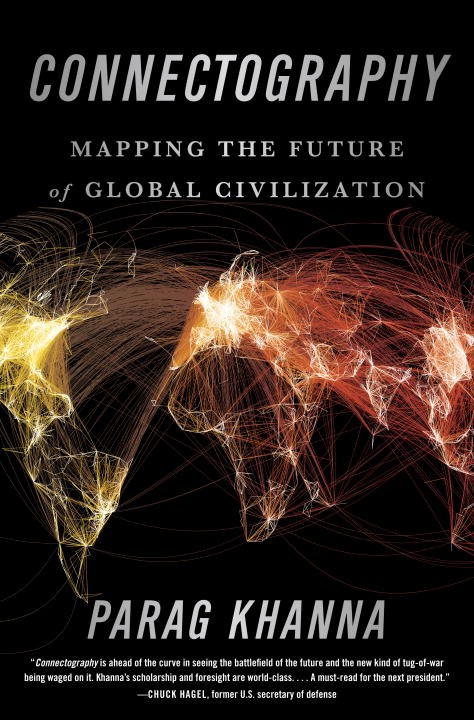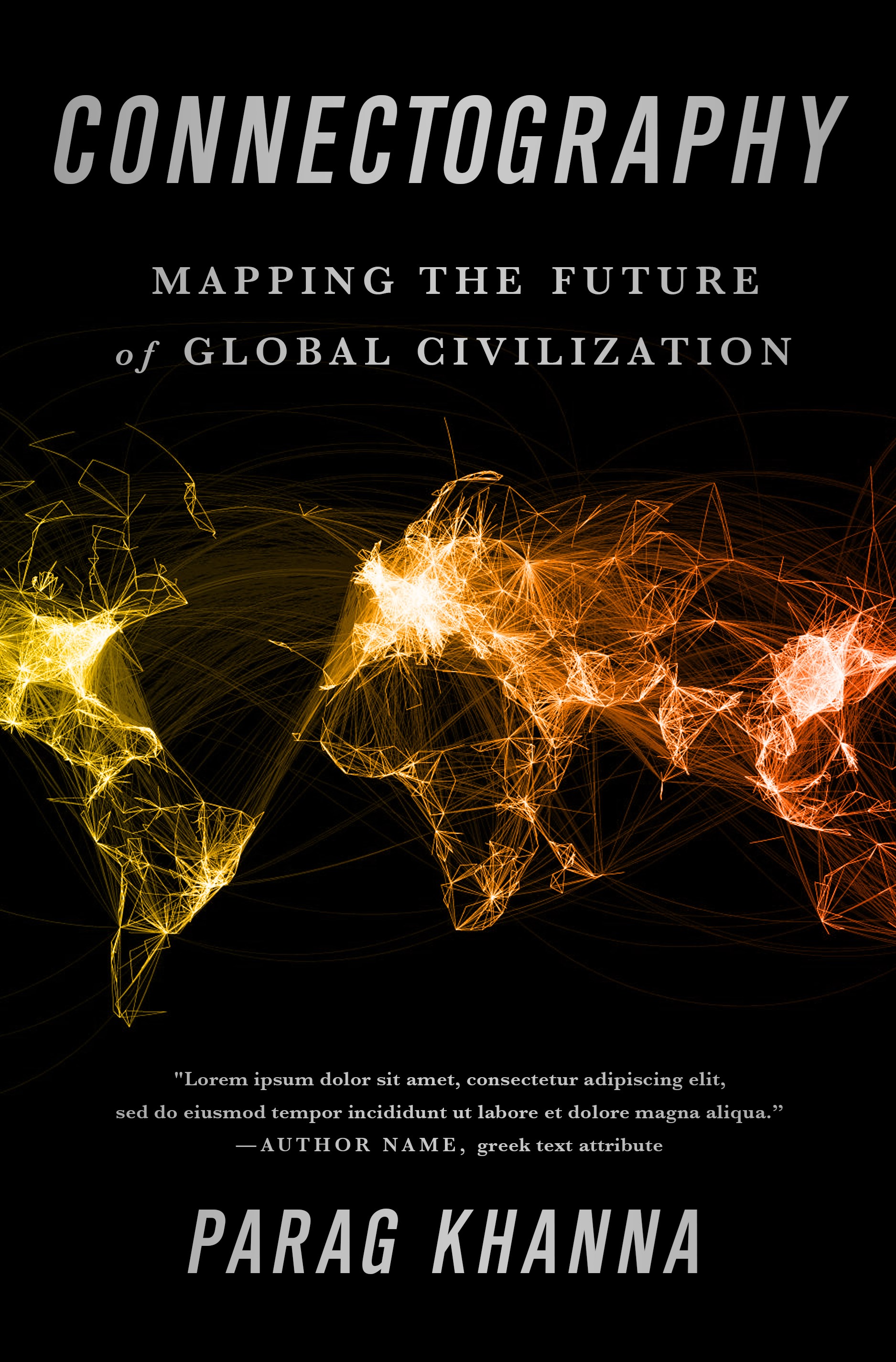Connectography: Mapping the Future of Global Civilization
April 19, 2016
A lover of maps from an early age, Parag Khanna talks about how to view and navigate the world "when both the 'death of globalization' and the 'age of hyper-globalization' are heralded with equal confidence."

When reading online or on my phone (I've become addicted to the feedly app for news), I tend to dive straight in and read articles before I check back to see who actually wrote them. So when I came across a brilliant opinion piece late last week—and printed on Sunday in the New York Times—about A New Map for America, I had no idea who was behind it while reading. But it was really exciting in a very specific way, one in which eminently practical and seemingly achievable ideas are at the same time completely transformational, where you see a better and more rational future on the page in front of you and wonder "why isn't this already a reality?" It was no surprise, when I scrolled back to the top, that I found Parag Khanna's name attached.
Parag, the author of The Second World and How to Run the World, is a visionary, and visual, thinker who offers a hopeful, yet realistic, (literal) map of the world's future. His new book, Connectography, does that in spades and hits bookshelves today, and Mr. Khanna was kind enough to share the prologue with us.
PROLOGUE
The natural consequence of any obsession is passing it on to one’s children. I’ve been collecting globes, maps, and other geographic artifacts since my itinerant childhood. Thus it is hardly a coincidence to have been writing portions of this book while methodically assembling a thousand-piece world map with my daughter. The map is a Mercator projection, named for the sixteenth-century Flemish geographer who sought to make maps more useful for navigation but in the process massively distorted the scale of the extreme latitudes. Hence my daughter exclaiming, “Greenland is so big!” (While also wondering why it was colored orange.) Africa was the easiest continent to piece together: With fifty-four countries, each little jigsaw shape was full of clues such as contrasting national colors and city names. We left the vast oceans for last—a truly frustrating slog, with hundreds of featureless pieces differentiated only by shades of blue. We passed the time discussing where the oceans are deepest, where the largest underwater mountain ranges are, and how people survive on remote islands.
When the entire puzzle was complete, we carefully wrapped it with a roll of wide, transparent tape and stuck it on her wall. Taking a step back, I could easily envision how neatly all the continents were once joined together as the supercontinent Pangaea and begin to imagine how over the next fifty to a hundred million years they will again cluster together (around the Arctic), fusing into another supercontinent scientists call Amasia.
But what if we are already connecting all the continents together today? What will our planet look like once we have built seamless transportation, energy, and communications infrastructures among all the world’s people and resources—when there is no geography that is not connected? A better term for it might be “Connectography.”
This book is about the staggering consequences of connectivity on almost every facet of our lives. It completes a trilogy on the future world order. The arc began with The Second World, a tour of the new geopolitical marketplace in which multiple superpowers compete for influence in major regions rife with instability and divisions. I argued, “Colonies were once conquered; today countries are bought.” And yet smart states practice a shrewd multi-alignment of being friendly with all great powers at the same time to extract maximum benefits without committing to deep alliances. The sequel How to Run the World examined the increasingly neo-medieval global landscape in which governments, companies, civic groups, and other players all compete for authority yet collaborate in a new kind of mega-diplomacy to tackle global challenges. It ended with a call for “universal liberation through exponentially expanding and voluntary connections” as the path to a global Renaissance. Connectography is about how we get there—literally and intellectually.
The road map of this book follows several interconnected thrusts. First, connectivity has replaced division as the new paradigm of global organization. Human society is undergoing a fundamental transformation by which functional infrastructure tells us more about how the world works than political borders. The true map of the world should feature not just states but megacities, highways, railways, pipelines, Internet cables, and other symbols of our emerging global network civilization.
Second, devolution is the most powerful political force of our age: Everywhere empires are splintering and authority is dissipating away from central capitals toward provinces and cities that seek autonomy in their financial and diplomatic affairs. But devolution has an important counterpart: aggregation. The smaller our political units get, the more they must fuse into larger commonwealths of shared resources in order to survive. This trend is playing out around the world from East Africa to Southeast Asia as dynamic new regional federations take shape through common infrastructures and institutions. North America too is growing into a truly united supercontinent.
Third, the nature of geopolitical competition is evolving from war over territory to war over connectivity. Competing over connectivity plays out as a tug-of-war over global supply chains, energy markets, industrial production, and the valuable flows of finance, technology, knowledge, and talent. Tug-of-war represents the shift from a war between systems (capitalism versus communism) to a war within one collective supply chain system. While military warfare is a regular threat, tug-of-war is a perpetual reality—to be won by economic master planning rather than military doctrine. Around the world, thousands of new cities or special economic zones (SEZs) have been constructed to help societies get themselves on the map in the global tug-of-war.
Another way this competitive connectivity takes place is through infrastructure alliances: connecting physically across borders and oceans through tight supply chain partnerships. China’s relentless pursuit of this strategy has elevated infrastructure to the status of a global good on par with America’s provision of security. Geopolitics in a connected world plays out less on the Risk board of territorial conquest and more in the matrix of physical and digital infrastructure.
Connectivity is a major driver of the deep shift toward a more complex global system. Economies are more integrated, populations are more mobile, the cyber domain is merging with physical reality, and climate change is forcing seismic adjustments on our way of life. The significant—and often sudden—feedback loops among these phenomena remain almost impossible to decipher. And yet even as connectivity makes the world more complex and unpredictable, it also offers the essential pathways to achieve collective resilience.
It is precisely in such times of uncertainty that people most want to know what’s next. The best we can do, however, is scenarios. During the Cold War, scenarios became an important way to examine how stability could suddenly mutate and escalate into hostility, how peace could give way to war. Today we build scenarios to depict what the world might look like if energy abundance is achieved or if resource competition intensifies, if global migration surges or if restrictions are enforced, if financial flows flood emerging markets or if policy shifts force capital to retrench, if inequality generates widespread political unrest or if governments recommit to delivering jobs and welfare. It’s easy to find evidence pointing in all directions.
Good scenarios therefore are about not predictions but processes: the greater the diversity of perspectives, the richer the scenarios that result. At a time when both the “death of globalization” and the “age of hyper-globalization” are heralded with equal confidence, assembling an accurate view of the future is less a matter of binary choices—a rosy versus a gloomy scenario—than of constructing a mélange of several visions. Today we don’t get to choose between a world of great power competition, globalized interdependence, and powerful private networks; we have all three at the same time.
In Connectography, I have combined elements from hundreds of scenarios along with my own research and observations from two decades of traveling to every corner of the world and analyzing global affairs. Thanks to phenomenal improvements in data visualization, some of these findings are depicted in the unique maps and graphics included herein and in the accompanying Connectivity Atlas available online at atlas.developmentseed.org. Whatever shape the world takes in the coming decades, there is still no substitute for a good map.
Excerpted from Connectography: Mapping the Future of Global Civilization with permission of the author.
Copyright © 2016 by Parag Khanna
All rights reserved.
ABOUT THE AUTHOR
A global strategist, world traveler and best-selling author, Parag Khanna is a CNN Global Contributor and Senior Fellow at the Lee Kuan Yew School of Public Policy at the National University of Singapore. He has been a fellow at the New America Foundation and Brookings Institution, advised the US National Intelligence Council and been a geopolitical advisor to US Special Operations Forces in Iraq and Afghanistan. He has traveled to more than 100 countries and is a Young Global Leader of the World Economic Forum.


